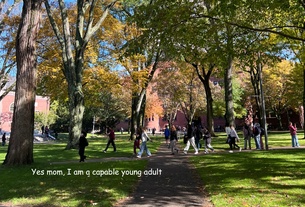When hedge fund billionaire Kenneth C. Griffin ’89 donated $150 million to Harvard for financial aid and an endowed professorship earlier this year, it was page one news from coast to coast. The gift—the largest in the history of the College—came just months after the University publicly launched its $6.5 billion capital campaign, and it provided clear evidence to many that the record-seeking fundraising effort was gaining traction among the University’s richest alumni.
On campus and in campaign stump speeches, the gift was lauded as “transformational” by Dean of Admissions and Financial Aid William R. Fitzsimmons ’67 and “a marvelous standard of generosity” by University President Drew G. Faust.
{shortcode-0419680b5ae1a750246b950e854903834dba6271}
But as it rippled through the national media, news of Griffin’s donation was accompanied by an oft-leveled criticism that supporting Harvard, and its $32.7 billion endowment, potentially comes at the expense of other worthy, yet less-established institutions. “Cut Off Harvard to Save America,” economist Richard K. Vedder wrote on BloombergView, joining several other pundits in a small but vocal criticism of adding to an already large reservoir of capital.
Indeed, giving to Harvard means giving to the richest institution of higher education in the world and one of the wealthiest nonprofit organizations in the United States. Every dollar put into Crimson coffers is one that could have gone elsewhere, to an aid organization or an independent laboratory with fewer resources, where experts say the impact is more immediately felt.
On the other hand, according to University donors and fundraising experts, Harvard’s ability to attract hundreds of millions of dollars in donations each year—including $1 billion in the last eight months alone—in such a crowded philanthropic marketplace points to the perceived value of investment and the savvy of its outreach. Where many other organizations offer a singular cause with potentially uncertain results, those alumni and experts say that Harvard presents donors with a proven track record of success and a unique stake in an elite community of scholars and leaders.
All things considered, they say, investing in Harvard’s social capital is one of the surest bets on the philanthropic market.
SEPARATING FROM THE CROWD
Of the more than $316 billion that the public service initiative Giving USA estimates Americans donated to charitable causes in Fiscal Year 2012, a near-record $31 billion went to colleges and universities, according to the Council for Aid to Education.
Given those numbers and Harvard’s own projected giving total, the University will likely be among the five or so highest grossing charitable causes in the United States when Harvard’s current fiscal year ends on June 30, among groups like the United Way, the Salvation Army, the Task Force for Global Health, and Feeding America. Stanford, Harvard’s closest university fundraising rival of late, which raised a record $931 million in Fiscal Year 2013, is expected to fall into second place after nine years at the front of the university fundraising pack.
All of which points, like Griffin’s gift, to the traction of Harvard’s campaign and the priorities that have been laid out for donors, they say.
Experts divide philanthropic gifts into two major categories: those that reduce suffering in the near and long term and those that invest in human potential. Giving to a higher education institution like Harvard capitalizes on both of those motivations, according to Eugene R. Tempel, president emeritus of the Indiana University Foundation and the founding dean of the School of Philanthropy there.
“If Harvard can do outstanding research with big brains and big egos I think that is worthwhile,” says Paul G. Schervish, the director of Boston College’s Center on Wealth and Philanthropy. “[Donors] look at the University as the foundation for intellectual capital.”
Harvard and other academic institutions can present donors with an all-embracing philanthropic opportunity—one in which supporters can donate to an art museum or cancer research or even unrestricted funds, contributing to the resolution of immediate global problems, while also financing future generations of problem solvers.
To this end, the University actively tries to sell itself to as many different types of donors as possible, playing to their individual interests, says Vice President of Alumni Affairs and Development Tamara E. Rogers ’74, a strategy that allows it to encompass the social missions of many other organizations.
{shortcode-924801678207787e69c41e4e84a2421ba0e3cf8a}
“What we want to do is to make them feel as though, given that they’re philanthropic, that Harvard is a place where they want to be philanthropic,” Rogers said. “It really is our responsibility to make them feel that out of all the different things that they could support in this country and in the world that Harvard makes a difference.”
Michael D. Smith, dean of the Faculty of Arts and Sciences and the head of its $2.5 billion campaign, echoes Rogers, explaining that tailoring the pitch to individual donors maximizes effectiveness.
“When I sit down with a donor and they say, ‘I have an ‘X’ amount of money to give, and I can give it to you or I can give it to this other very worthy charity down the street,...[I respond that] each dollar that’s given is actually going to very meaningful activities, like financial aid, like the things we’re trying to do in the Houses, and so forth,” Smith said. “And when you start explaining it like that, it’s very meaningful especially to our own alumni who have experiences here, or to parents who have children who are now experiencing what’s happening here.”
For high-wealth donors, for whom giving to charitable causes is not a zero-sum game, excitement about a cause is as important as its worthiness, administrators and philanthropy experts say, and each individual must negotiate a personal set of factors.
“You can always trump someone’s philanthropy—you can always say you should be giving your money to ‘X’ or ‘Y’ cause instead,” Schervish says. “There’s always this possibility that what you see as more important is something that other people are not inspired to give to.”
TRIED AND TRUE
If an exciting cause is necessary to get donors to the negotiating table—be it for a building, a professorship, or a scholarship fund—the decision to make a gift is ultimately based largely on confidence in the institution to carry out its objective.
Many upper-level donors view their philanthropy in terms of a “portfolio,” according to Frederick M. Hess, the director of education policy studies at the American Enterprise Institute. And these donors see Harvard as a long-term, low-risk investment compared to many other younger, more volatile causes.
“It may or not be the most exciting thing you can do—it's not a startup, it's not going to eradicate malaria,” said Richard A. Marker, the founder of New York University’s Academy for Grantmaking and Funder Education. “But in the long run...there's a very, very high likelihood that it will do something good.”
For many potential donors, Harvard’s track record of producing world-leading ideas and people, as well as its sophisticated organizational structure, indicate that the University is well-equipped to handle and use donations effectively.
“They have a plan put in place to deal with that money,” said Maria Di Mento, an assistant editor for the Chronicle of Philanthropy who covers big giving. “Large institutions know what to do with the money, they really have a plan of how to handle the money, and they can offer something that donors can see.”
Hess says that with Harvard’s celebrated faculty, for example, donors who endow a professorship do not have reason to worry. “If one professor leaves, the whole [organization] will not fall apart.”
{shortcode-4f3db92e53f33c5aa7d183a8ce785982cc237568}
Donors interviewed for this story largely agree, saying that giving to Harvard entails a perpetuation of historical excellence that relies on the reputation of the past and continues it into the future. In the same way that Faust describes Harvard’s investment perspective as “long-term,” donors often view their gifts to Harvard as long-term investments in a better world.
“If you want to have an impact on the world, I can’t think of a better way to have your funds used with great leverage. I’m giving to one of the great educational institutions in the world,” says long-time University donor and venture capitalist Sidney R. Knafel ’52. “The extent that I can help that institution to raise its standard, to raise the standards of education institutions all over, will create a better educated populace in the future who will probably do a better job than we did.”
Even bumps in the investment record, like Harvard’s decades-long foray into Allston, questions about the management of its natural resources investments, or professorial ethics violations, tend to have little effect on the overall confidence in the University’s ability to translate gifts into successful research or other outcomes.
What’s more, according to Schervish, at a large university where money is fungible, even the impact of earmarked gifts will extend beyond a particular short term initiative.
“There are alumni that you are always in touch with and bringing on campus for tours and roles like the Board of Overseers and so forth, and you want them to recognize that the University is changing, and you need to stay on the leading edge of knowledge in fields that demand that people be a little bit flexible about their willingness to support,” says David Yermack ’85, who is an alumnus of the College, the Graduate School of Arts and Sciences, the Law School, and the Business School.
PAYING TO BE A PART OF THE CLUB
Long before a donor ever gives Harvard a monetary gift, big or small, the University has in most cases been working to inspire confidence and maintain loyalty. And unlike other charitable causes where donations result in merely a letter of thanks or a one-time award, Harvard offers its backers a continued stake in an influential community long after they leave campus or even if they never stepped foot on it.
From the the senior class gift to a donor’s inclusion of Harvard in his or her will, the University employs a host of committees, reunions, networking events, and, for a wealthy few, access to top professors and leadership, to keep potential donors involved and invested. More than just altruistic satisfaction, giving to Harvard has tangible benefits.
“Once you give serious money, they never let go of you,” says Byron R. Wien ’54, a vice chairman at Blackstone Advisory Partners who donated both a professorship in drama and one in the life sciences. “Someone in the development office maintains a relationship with you and will be a presence in your life,” Wien added.
{shortcode-5766600ee1486c8e4d394ca868871b00bd137372}
Rogers insists that while “alumni don’t owe us philanthropy,” the Alumni Affairs and Development Office ensures that donors meet representatives of the University that could engage their interest. Griffin, for example, has become close friends with Smith, according to Faust.
“Harvard keeps contributing to their life,” Schervish says, adding, “Harvard is the gift that keeps on giving, and that’s why Harvard gets gifts.”
Smaller donors, who Rogers delineated as those who contribute $10,000 or less, cite allegiance to Harvard and the desire to give back to perpetuate the opportunities from which they benefited as reasons they give.
“I am aware that for centuries people have had their educations subsidized at Harvard by alumni who donate back to the school,” says Yermack, adding that he and his wife “want to contribute to the education of the next generation knowing that the previous generation contributed to ours.”
Yermack’s perspective speaks to the University’s multilayered appeal. Familiarity and an appreciation for its mission mix with confidence in its capacity to bring an ever-widening array of goals to the marketplace of ideas.
“Whatever money I give will go a lot further than if I do it on my own or give to a lesser organization in terms of name recognition and convening power,” says Paul Zofnass ’69, who established a sustainability initiative at the Graduate School of Design with a $500,000 donation in 2008. “If you want to do some good things, having Harvard involved can power it through.”
—Staff writer Amna H. Hashmi can be reached at amna.hashmi@thecrimson.com. Follow her on Twitter @amna_hashmi.
—Staff writer Tyler S. Olkowski can be reached at tyler.olkowski@thecrimson.com. Follow him on Twitter @OlkowskiTyler.


